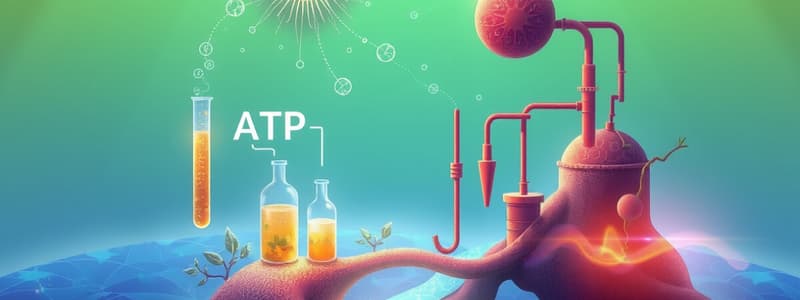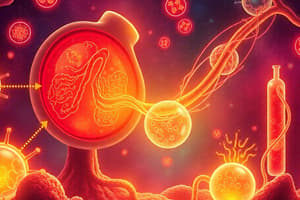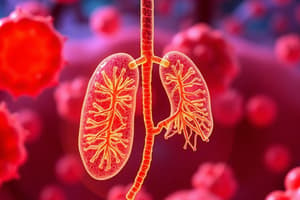Podcast
Questions and Answers
How much ATP does aerobic respiration produce?
How much ATP does aerobic respiration produce?
38 ATP
How much ATP does anaerobic respiration produce?
How much ATP does anaerobic respiration produce?
2 ATP
How much ATP does fermentation produce?
How much ATP does fermentation produce?
none
How do organisms generate energy without oxygen present?
How do organisms generate energy without oxygen present?
What is fermentation?
What is fermentation?
What does fermentation use instead of an electron transport chain to generate ATP?
What does fermentation use instead of an electron transport chain to generate ATP?
What is the final acceptor for NADH electrons during fermentation?
What is the final acceptor for NADH electrons during fermentation?
What are the two common types of fermentation?
What are the two common types of fermentation?
Define alcohol fermentation.
Define alcohol fermentation.
What are the byproducts of alcohol fermentation?
What are the byproducts of alcohol fermentation?
What uses alcohol fermentation?
What uses alcohol fermentation?
Define lactic acid fermentation.
Define lactic acid fermentation.
What uses lactic acid fermentation?
What uses lactic acid fermentation?
Define lactate dehydrogenase.
Define lactate dehydrogenase.
Define obligate anaerobes.
Define obligate anaerobes.
Define facultative anaerobes.
Define facultative anaerobes.
How do carbohydrates enter the catabolic pathway?
How do carbohydrates enter the catabolic pathway?
How do lipids enter the catabolic pathway?
How do lipids enter the catabolic pathway?
Define beta oxidation.
Define beta oxidation.
Where does beta oxidation occur in prokaryotes?
Where does beta oxidation occur in prokaryotes?
Where does beta oxidation occur in eukaryotes?
Where does beta oxidation occur in eukaryotes?
How is the activity of a pathway controlled?
How is the activity of a pathway controlled?
How are the enzymes that control metabolic pathways regulated?
How are the enzymes that control metabolic pathways regulated?
What are two ways that glycolysis is regulated?
What are two ways that glycolysis is regulated?
Define feedback regulation.
Define feedback regulation.
Define feedback inhibition.
Define feedback inhibition.
Flashcards are hidden until you start studying
Study Notes
ATP Production
- Aerobic Respiration generates 38 ATP from one glucose molecule.
- Anaerobic Respiration produces only 2 ATP per glucose.
- Fermentation does not yield additional ATP as NADH produced in glycolysis is fully consumed.
Fermentation Process
- Fermentation extracts energy from food by producing ATP without oxygen.
- It converts NADH and pyruvate back to NAD+ and an organic molecule to sustain glycolysis.
- Uses Substrate-Level Phosphorylation to generate ATP instead of an electron transport chain.
- The final electron acceptor for NADH during fermentation is pyruvate.
Types of Fermentation
- Common types include Alcohol Fermentation and Lactic Acid Fermentation.
- Alcohol Fermentation converts sugars into energy, producing ethanol and carbon dioxide as byproducts.
- Lactic Acid Fermentation forms lactic acid from pyruvate with NADH; no oxygen is required.
Applications of Fermentation
- Alcohol Fermentation is utilized by yeast in producing alcoholic beverages, ethanol fuel, and bread.
- Lactic Acid Fermentation is used by fungi, bacteria, and human muscle cells under anaerobic conditions.
Enzymes and Pathways
- Lactate dehydrogenase catalyzes the conversion of lactate to pyruvic acid and plays a role in regenerating NAD+.
- Obligate Anaerobes rely solely on fermentation or anaerobic respiration and are harmed by oxygen.
- Facultative Anaerobes can generate ATP via aerobic respiration when oxygen is available but switch to anaerobic methods when it is not.
Catabolism and Lipid Metabolism
- Carbohydrates typically enter cellular respiration through glycolysis.
- Lipids enter via Beta Oxidation, breaking down fatty acids into acetyl-CoA for the Citric Acid Cycle.
- Beta Oxidation occurs in the cytosol of prokaryotes and in mitochondria of eukaryotes.
Regulation of Metabolic Pathways
- Pathway activity is modulated via enzyme regulation at allosteric sites by regulatory molecules.
- Phosphofructokinase and Pyruvate Dehydrogenase are key enzymes in glycolysis regulation.
- Feedback Regulation utilizes the end product of a pathway to control its own pathway activity.
- Feedback Inhibition occurs when a pathway's end product inhibits an enzyme within that same pathway.
Studying That Suits You
Use AI to generate personalized quizzes and flashcards to suit your learning preferences.




